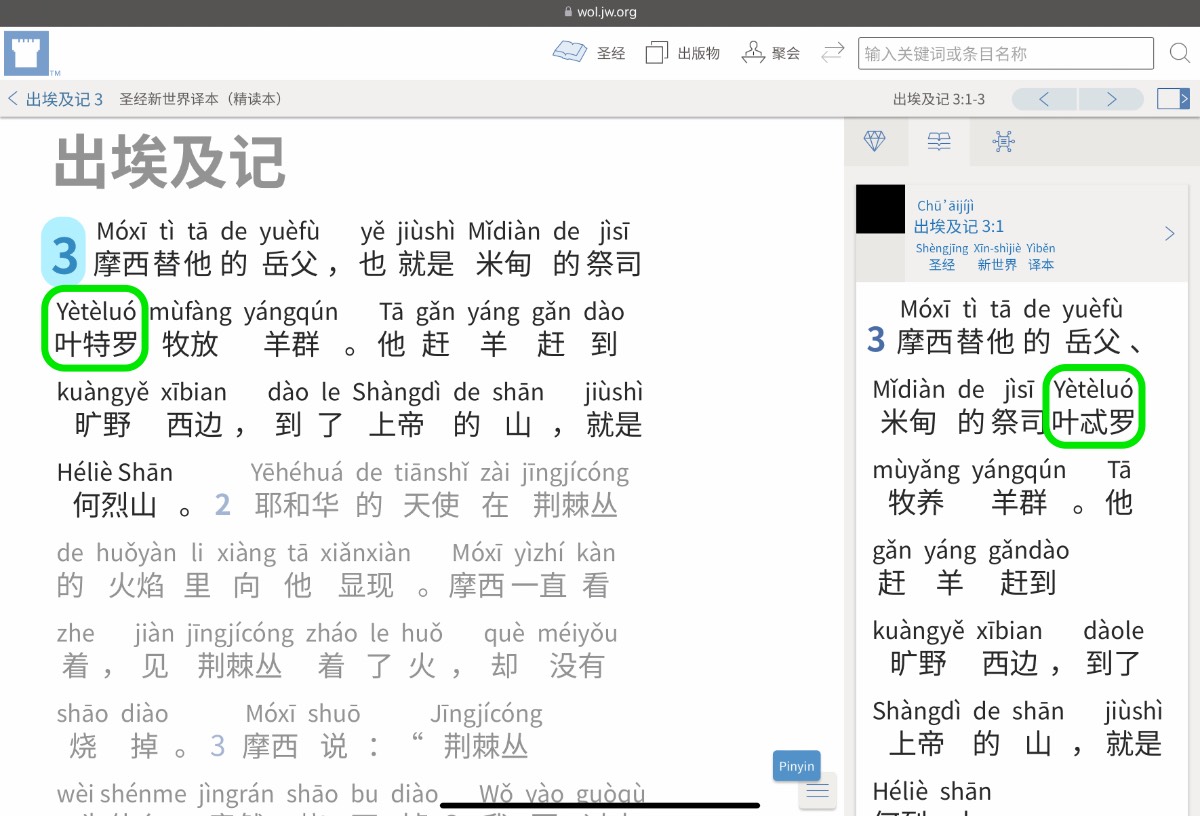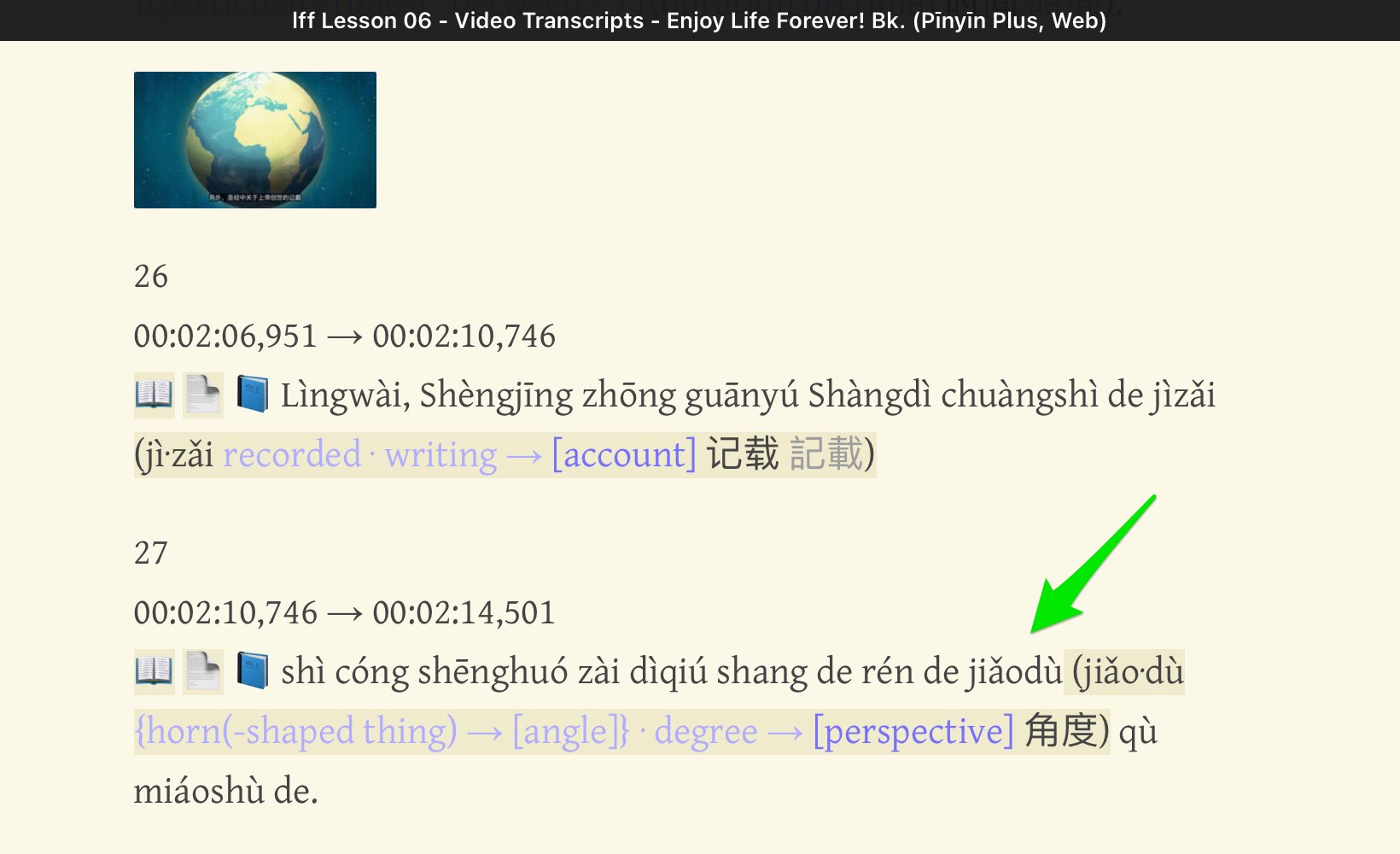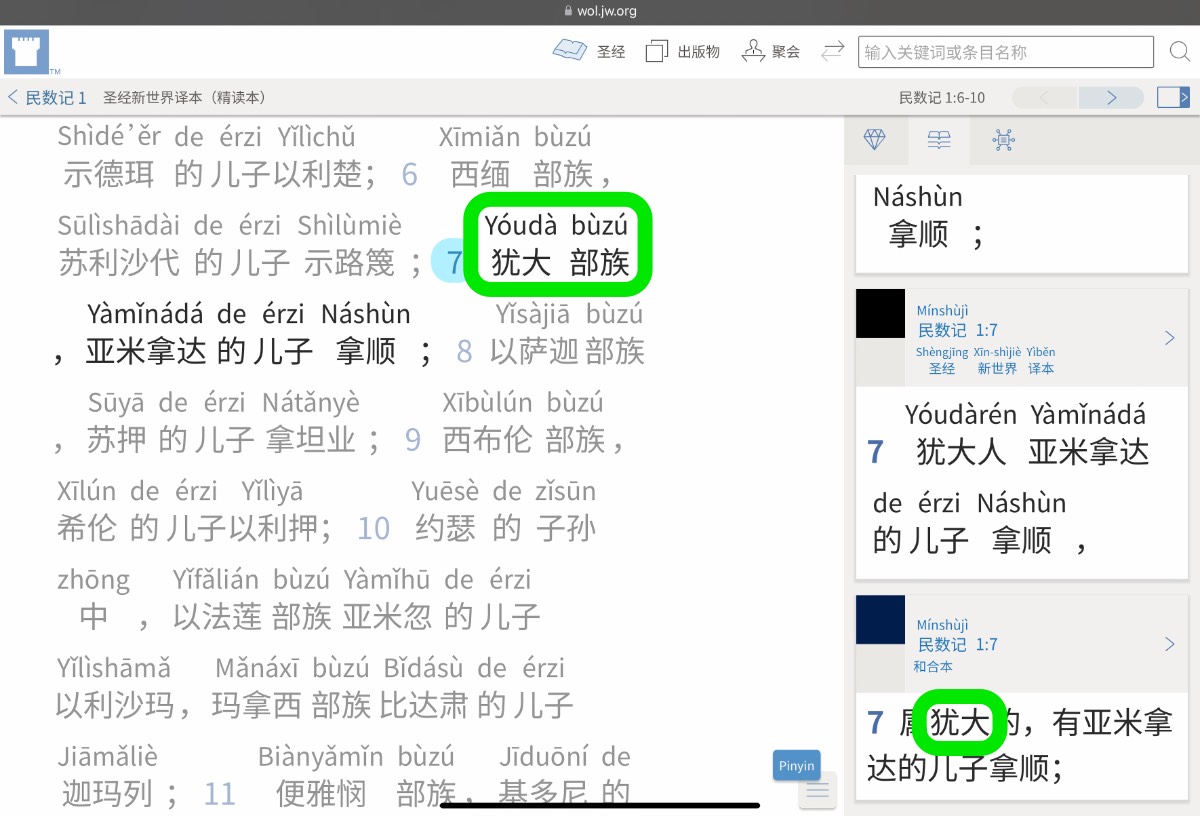Yètèluó (Jethʹro 叶特罗 葉特羅) ← Tap/click to show/hide the “flashcard”
Appendix A2 of the English New World Translation of the Holy Scriptures (Study Edition), entitled “Features of This Revision”, discusses vocabulary changes that have been made in the current revision, words that have been translated differently than before. As noted in various entries in the excellent resource Referenced Theo. Expressions (RTE), Appendix A2 of the current Mandarin version of the New World Translation Bible (nwtsty) correspondingly discusses words that have been translated differently in the current revision of the Mandarin NWT Bible, compared to how they had been translated before.
Since we base what we say in Jehovah’s service on his Word the Bible, the vocabulary used in it—and the way those vocabulary words are translated—should be reflected in how we speak in our ministry, at our meetings, etc. So, it is beneficial for us Mandarin field language learners to be familiar with the latest thinking from the organization on how Bible terms should be translated into Mandarin.
Avoiding Rarely‐Used, Hard‐to‐Recognize Characters
Appendix A2 of the current Mandarin version of the New World Translation Bible (nwtsty) mentions that one of the goals for this version was to reduce the number of hard-to-recognize, hard-to-read Chinese characters used, and to replace them with more commonly used characters. The first example it provides is that “Yètèluó (Jethʹro (old way of writing with characters) 叶忒罗 葉忒羅)” was changed to this week’s MEotW, “Yètèluó (Jethʹro 叶特罗 葉特羅)”.—Exodus 3:1.

While the pronunciation and the Pīnyīn (Pīn·yīn {Piecing Together of} · Sounds → [Pinyin] 拼音) were kept the same, a relatively rarely-used, hard-to-recognize character (“忒”) was replaced with a different, more common and recognizable character (“特”). As we can see, the translators who worked on the current version of the Mandarin NWT recognized that it was good to preserve the spoken pronunciation of the expression, an expression that as a whole was not changed. At the same time, they did not consider the particular character that was replaced to be sacred. This reinforces to us the basic principle of linguistics (language science) that SPEECH is primary, not writing, which shows up the traditional and ongoing Chinese cultural emphasis on characters as being fundamentally misplaced.
A Real-Life Example
The importance of avoiding unnecessarily hard-to-recognize characters was well demonstrated by the incident discussed in the tiandi.info blog post “An Avoidable Minefield of Human Tradition and Cultural Pride” (Email me if you need login information, and include information on who referred you and/or what group/cong. you are in.):
A few nights ago, my Mandarin congregation had a Memorial meeting that went well overall. However, there was a momentary hiccup that I think we Chinese field publishers can learn from.
The speaker who gave the talk is a fluent, eloquent native Mandarin speaker originally from mainland China, and he is one of the best Mandarin speakers in a city of several Mandarin congregations. In fact, he was one of the instructors in the very first official Mandarin class ever held in this country. However, while reading a scripture from his paper Bible as he was giving the Memorial talk, he, of all people, just…got…stuck…on…a…Chinese…character…. He struggled with it for what felt like quite a while, and eventually, a young brother who was serving as an attendant at the side of the stage approached and gave him a hint, and he was able to carry on.
…
While not a showstopper, this unfortunate incident was indeed an awkward showpauser, during the very meeting, out of all the meetings in the entire service year, at which the highest proportion of interested ones from the field was present—truly a nightmare scenario for anyone who gives Chinese talks!
FYI, in this case, the character that the brother couldn’t read was the “虺” in “虺蛇”, which has been replaced in the current version of the Mandarin NWT with “眼镜蛇”. (Isaiah 11:8) (While not being especially visually complex compared to some other Chinese characters, “虺” is relatively rarely used, ranking way down at #5543 on Prof. Dá Jùn (Dá {Tow Rope} (surname) 笪) ((Jùn {Fine Horse} 骏 駿) (Associate Professor of Linguistics, Director of the Media Center for Language Acquisition Department of Foreign Languages and Literatures, Middle Tennessee State University))’s character frequency list of Modern Chinese. “眼” is #281 on that list, and “镜” is #1251.)
Mitigations and Alternatives
In a way, though, even such fine efforts on the part of the NWT translators, working with what they have, are mere mitigations. On a more basic level, the incident mentioned above also highlights the problematic nature of the Chinese characters writing system itself, which makes it all too possible for such hard-to-recognize characters to exist, without any reasonable, consistent, and reliable system to work out their pronunciations. This makes any block of Chinese characters a potential minefield that can blow up in the face of even the most knowledgeable and experienced native speaker, because even such a one is still a mere imperfect human contending with the inhumanly complex and numerous Chinese characters, of which there are over 100,000.
In contrast, Pīnyīn (Pīn·yīn {Piecing Together of} · Sounds → [Pinyin] 拼音), with its Latin alphabet letters and four tone symbols, is a simple, elegant full writing system for Modern Standard Mandarin that is eminently learnable by mere imperfect humans. Thus, it is an eminently good thing that Jehovah, through his organization, has made official Pīnyīn (Pīn·yīn {Piecing Together of} · Sounds → [Pinyin] 拼音) available for the current version of the Mandarin NWT Bible, unlikely and uncommon though such a provision is from a worldly, human viewpoint. (Work is also ongoing to provide unofficial Pīnyīn (Pīn·yīn {Piecing Together of} · Sounds → [Pinyin] 拼音) Plus material for the current version of the Mandarin NWT, as language-learning material, not as spiritual food.)

